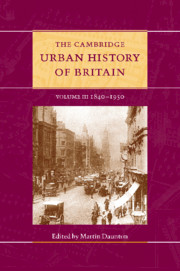Book contents
- Frontmatter
- 1 Introduction
- Part I Circulation
- 2 Urban networks
- 3 Modern London
- 4 Ports
- 5 The development of small towns in Britain
- 6 Migration
- 7 Pollution in the city
- 8 From Shillibeer to Buchanan: transport and the urban environment
- Part II Governance
- Part III Construction
- Part IV Getting and spending
- Part V Images
- Select bibliography
- Index
- Plates 1-7
- Plates 8-14
- Plates 15-20
- Plates 21-27
- Plates 28-34
- Plates 35-41
- Plates 42-48>
- Plates 49-53
- References
2 - Urban networks
from Part I - Circulation
Published online by Cambridge University Press: 28 March 2008
- Frontmatter
- 1 Introduction
- Part I Circulation
- 2 Urban networks
- 3 Modern London
- 4 Ports
- 5 The development of small towns in Britain
- 6 Migration
- 7 Pollution in the city
- 8 From Shillibeer to Buchanan: transport and the urban environment
- Part II Governance
- Part III Construction
- Part IV Getting and spending
- Part V Images
- Select bibliography
- Index
- Plates 1-7
- Plates 8-14
- Plates 15-20
- Plates 21-27
- Plates 28-34
- Plates 35-41
- Plates 42-48>
- Plates 49-53
- References
Summary
Nature prepares the site, and man organizes it in such fashion as meets his desires and wants.
Vidal de la Blache, 1898In 1950, a spider-web of railways overlay the British landmass from western Cornwall to the eastern tip of Caithness. Tracks fanned out from London through cities to the coastal settlements of Wales and Scotland, while branch lines moved from mills, mines, resorts and ports to the county towns (see Map 2.1). Commuters rushed from suburbs into London, Glasgow and Manchester, metropolitan centres surrounded by a dense penumbra of roads and rails. Threadlines of transport connected a human geography of settlement. In the eyes of the mapmaker, cities and their interconnections had tamed a world of mountain and plain, turning natural spaces into corridors, making the remote accessible. A century earlier, the transport network had a more truncated shape. Around 1840, railways linked London only to the largest county towns and the industrial centres of the North; they had scarcely reached Cornwall, Wales or the Scottish Highlands (see Map 2.2). A decade later, many new lines connected East and West, North and South, but large sections of Britain remained unreachable by railway (see Map 2.3). Moreover, roads had not yet swollen to accommodate automobiles and the needs of suburban residents. Cities, other than London and a few regional centres, remained small in size. The urban had not yet dwarfed the rural.
Keywords
- Type
- Chapter
- Information
- The Cambridge Urban History of Britain , pp. 57 - 94Publisher: Cambridge University PressPrint publication year: 2001
References
- 1
- Cited by

